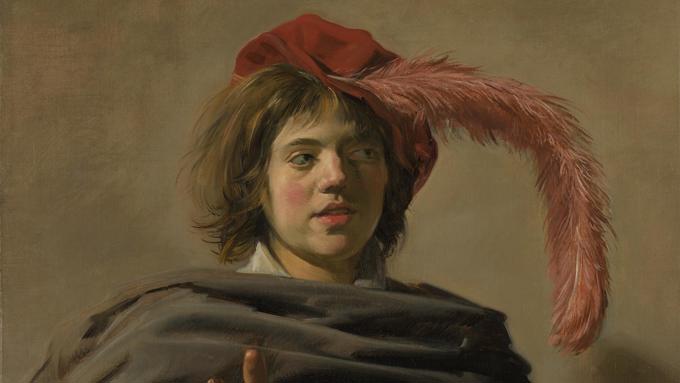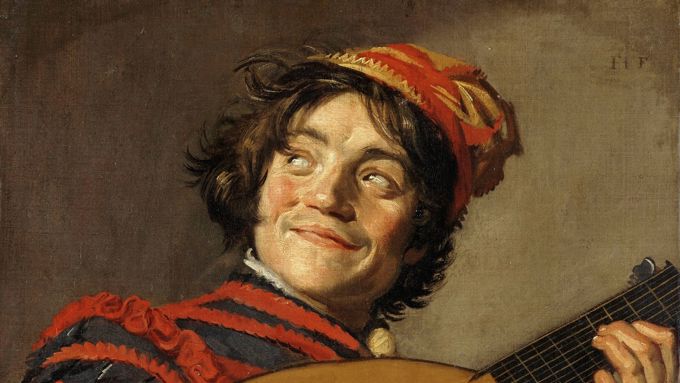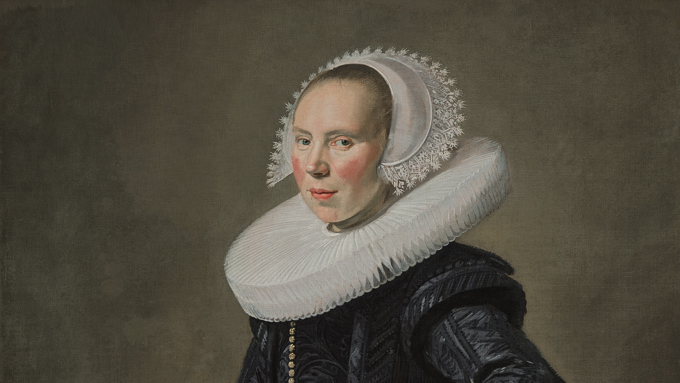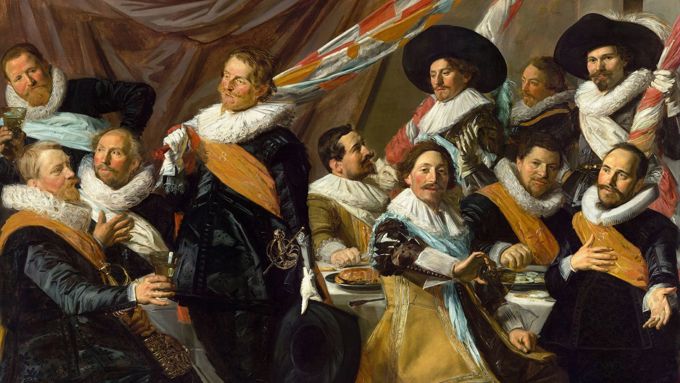Gemäldegalerie, Berlin: 12 July 2024 – 3 November 2024'
The largest exhibition devoted to the work of Frans Hals for more than thirty years opens at the National Gallery this autumn.
The Credit Suisse Exhibition: Frans Hals (30 September 2023 – 21 January 2024) is the first large-scale monographic exhibition devoted to the 17th-century Dutch portrait painter for a generation.
The exhibition, which is organised with the Rijksmuseum, Amsterdam, and the Gemäldegalerie, Staatliche Museen zu Berlin, contains some fifty of the artist’s greatest works from museums and private collections around the world. As well as key loans from the Rijksmuseum, and other Dutch collections including the Frans Hals Museum, Haarlem, highlights in the exhibition include 'Isaac Abrahamsz. Massa', 1626 (Art Gallery of Ontario, Toronto);' Portrait of Pieter Dircksz. Tjarck', about 1635 (Los Angeles County Museum of Art, California); 'The Rommel-Pot Player', about 1620 (Kimbell Art Museum, Fort Worth, Texas); 'Portrait of Tieleman Roosterman', 1634 (The Cleveland Museum of Art, Cleveland, Ohio).
The exhibition will also include one of the world’s best-known pictures, Frans Hals’s 'The Laughing Cavalier', which will come to Trafalgar Square from its home in the Wallace Collection, Manchester Square, where it has been on display since the 1870s. The painting, dating from 1624, will be on loan following the Wallace Collection’s landmark decision in 2019 to lend works from its collection on a temporary basis for the first time in its 120-year history.
'The Laughing Cavalier' is one of the finest examples of the artist’s work which, in his own lifetime, was recognised for its exceptionally lively characterisation of people. He was one of the very few artists throughout the history of Western painting who successfully managed to paint people smiling and laughing; a challenge shunned by most painters because it was so difficult.
Since the rediscovery of his work in the 19th century, Hals’s paintings have been held in high regard and have been popular with the public, but it is more than thirty years since a large exhibition devoted to his work was held in Washington, London, and Haarlem, in 1989–90.
Hals’s quick painting technique earned him his reputation as a virtuoso whose handling of the brush was equalled only by the likes of Rembrandt in the Netherlands and Velázquez in Spain. However, his work almost faded into oblivion for much of the 18th and 19th centuries. His bravura as a painter had to wait to be rediscovered in the second half of the 19th century by the art critic and journalist Théophile Thoré-Bürger, who rediscovered Vermeer; and by the Impressionists, who greatly admired Hals’s brushwork.
The exhibition will follow a largely chronological display of portraits. There are separate sections for genre paintings and small portraits, allowing space for Hals’s unsurpassed group portraits from the Frans Hals Museum in Haarlem which have rarely left the city since they were painted some four centuries ago.
The first section of the exhibition will be devoted to Hals’s Early Work. It focuses on his extraordinary technique and the sense of living presence this creates and which was evident from his earliest paintings such as 'Portrait of Catharina Hooft with her Nurse', about 1620 (Staatliche Museen zu Berlin, Gemäldegalerie).
In Portraiture into Art the exhibition explores how Hals’s fresh, energetic approach allowed him to transform portraiture from a merely functional genre into an expressive, imaginative art form. Preparing the ground for subsequent sections, it will explain the context of commissioned portraits and how the need to create a good likeness initially put some constraints on Hals’s gestural brushwork. This section will also highlight how Hals’s free technique contributed to the lively and informal poses and expressions of his sitters. Key works in this section are 'Willem van Heythuysen', about 1625 (Bayerische Staatsgemäldesammlungen, Munich – Alte Pinakothek), 'The Laughing Cavalier', 1624 (The Wallace Collection, London) and 'The Banquet of the Officers of the St George Civil Guard', 1627 (Frans Hals Museum, Haarlem).
Invented Characters includes scenes of everyday life that Hals painted mainly in the 1620s and 1630s. Portraying characters from everyday life as opposed to paying clients, genre paintings gave Hals the freedom to push the speed and dynamism of his brushwork and the liveliness of his characterisation. The genre pictures show how Hals engaged with subjects that were popular in Rederijkerskamers (Chambers of Rhetoric), dramatic societies whose performances and poetry featured outlandish characters and imagery. This section includes 'Malle Babbe,' about 1640 (Staatliche Museen zu Berlin, Gemäldegalerie), 'The Lute Player', about 1623 (Musée du Louvre, Paris), 'Young Man holding a Skull (Vanitas)', about 1627, (The National Gallery, London) and 'Pekelharing (The Merry Drinker)', about 1628 (Museum der bildenden Künste Leipzig/Museum of Fine Arts Leipzig).
Family Ties highlights the subtlety and warmth with which Hals captured the relationships between his sitters. Long-separated pendant portraits of married couples are reunited with other family portraits. This section amplifies the exhibition's principal idea that Hals raised the genre of portraiture to art; transforming what had been cold records of genealogy into intimate familial scenes. Portraits in this section include 'Family Group in a Landscape', about 1646 (Museo Nacional Thyssen-Bomemisza, Madrid); 'Portrait of a Couple, probably Isaac Abrahamsz. Massa and Beatrix van der Laen', about 1622 (Rijksmuseum, Amsterdam); and 'Isaac Abrahamsz. Massa', 1626 (Art Gallery of Ontario, Toronto).
Up Close shows how Hals could adapt his expressive brushwork for smaller works and explores the function of pictures such as 'Willem van Heythuysen Seated in a Chair', about 1638 (Private Collection).
The final room Late Work celebrates the unprecedented technical freedom of Hals's final decades. It also points to his artistic legacy, from being a feted (though impoverished) artistic son of Haarlem, given a pension by the city, to his rediscovery in France in the 19th-century by the Impressionists and their circle. Key works here are the 'Regents of the Old Men's Alms House', about 1664 (Frans Hals Museum, Haarlem); 'Portrait of a Man in a Slouch Hat', about 1660 (Museumslandschaft Hessen Kassel, Gemäldegalerie Alte Meister); 'Jasper Schade', 1645 (National Gallery, Prague)
At the National Gallery The Credit Suisse Exhibition: Frans Hals is curated by Bart Cornelis, Curator of Dutch and Flemish Paintings. At the Rijksmuseum, the exhibition is curated by Friso Lammertse, Curator of 17th-Century Dutch Paintings.
A version of the exhibition at the Gemäldegalerie, Berlin, which will include works by Hals’s contemporaries and explores his influence in later periods, is curated by Dr Katja Kleinert, Curator for Dutch and Flemish Art of the 17th Century.
Bart Cornelis, Curator of The Credit Suisse Exhibition: Frans Hals, says: ‘It is very exciting to be able to present the first major monographic show devoted to Frans Hals for more than thirty years. No museum has, during that time, attempted to present a survey of his work. This means that no one under the age of 40 has been able to acquaint themselves, through a comprehensive overview, with the genius of one of the greatest portrait painters of all time.’
Dr Gabriele Finaldi, Director of the National Gallery, says: ‘Hals was the brilliant, daring and inventive contemporary of Rembrandt, whose lively portraits and virtuoso brushwork have fascinated generations of artists, perhaps most notably Edouard Manet. The National Gallery is delighted to be working with the Rijksmuseum, Amsterdam, and the Berlin Gemäldegalerie and the Frans Hals Museum, Haarlem, on this exhibition.’
A spokesperson for Credit Suisse says: ‘Credit Suisse is delighted to be supporting The Credit Suisse Exhibition: Frans Hals at the National Gallery, London. Credit Suisse has been a partner of the National Gallery since 2008 and is proud to have supported unique cultural experiences for our clients, employees, key partners, and the public.’
The exhibition is organised by the National Gallery, the Rijksmuseum, Amsterdam, and the Gemäldegalerie, Staatliche Museen zu Berlin, with the special collaboration of the Frans Hals Museum, Haarlem.
Detail from Frans Hals, 'Young Man holding a Skull (Vanitas)', 1626-8
Detail from Frans Hals, 'The Lute Player', about 1623 © Musée du Louvre, Paris, Department of Paintings
Image: Detail from Frans Hals, 'Banquet of the Officers of the St George Civic Guard', 1627 © Frans Hals Museum, Haarlem



